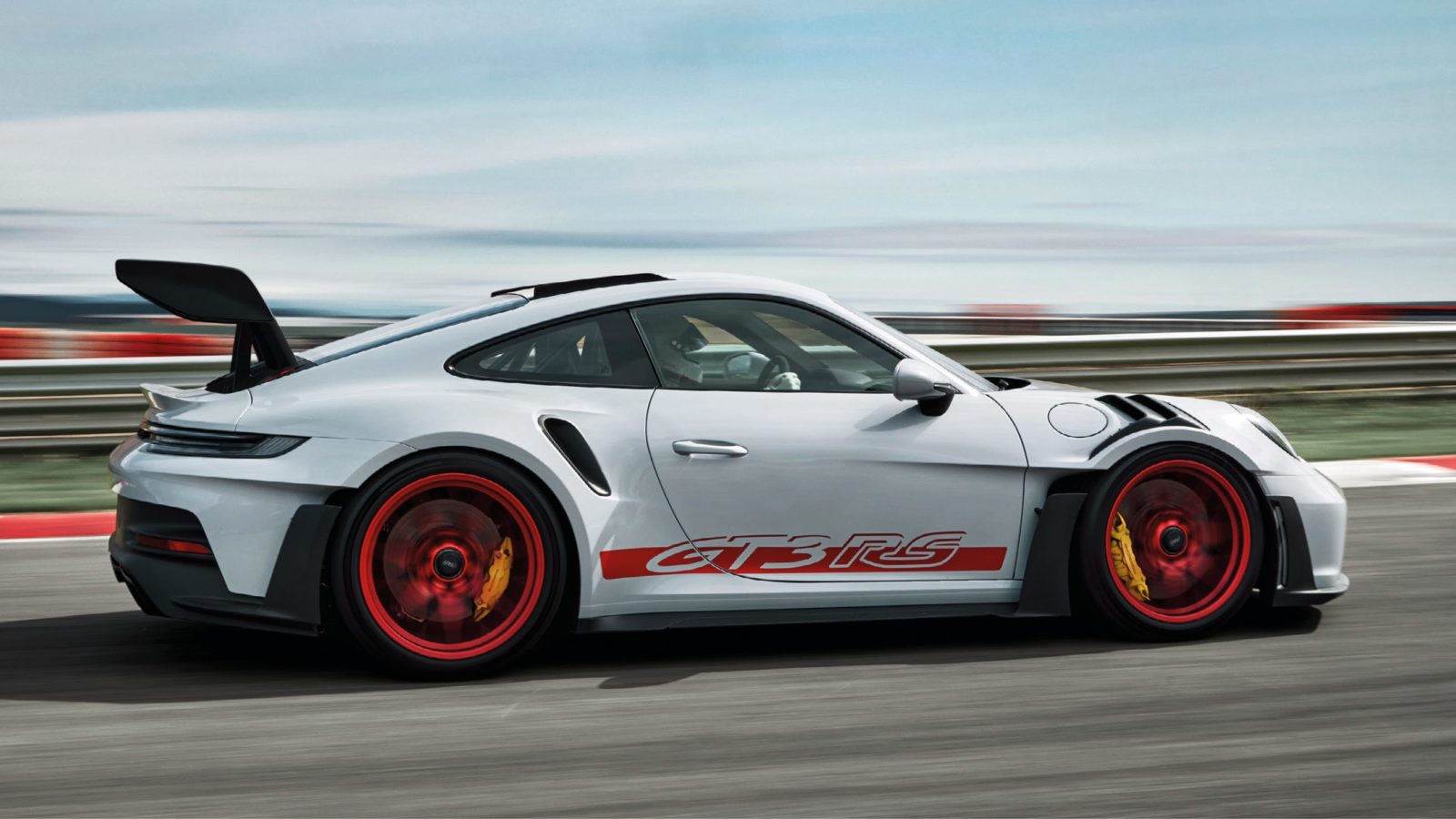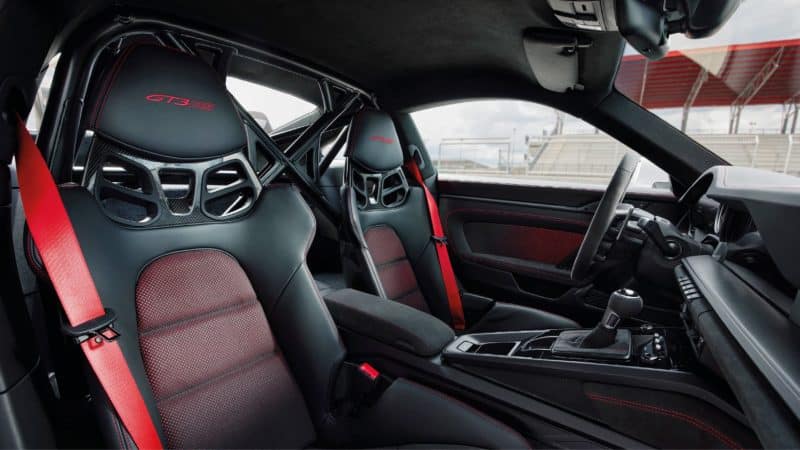2022 Porsche 911 GT3 RS review: Downforce to be reckoned with
Porsche has focused on aero to squeeze more from its 911 GT3 RS. Andrew Frankel takes to the track to see what this means

The huge rear wing creates up to 860kg, which is more than double that of the previous GT3 RS
It was, on reflection, the only way Porsche could go. It couldn’t make its new 911 GT3 RS more powerful while retaining a naturally aspirated and legally compliant engine, nor could it make it significantly lighter, because it’s already as light as a fully homologated road car not using a bespoke platform can reasonably be. So how else do you make a big performance gain if your power to weight ratio must remain unchanged? Aero, is the answer.
There is not space here to explain all the modifications to the standard GT3 aero package that resulted in the GT3 RS – some you can see like the vast, DRS-equipped rear wing, the cut outs behind the wheels and front spoiler, and others like the active flaps under the front wings, fully panelled underside and rear diffuser you cannot. But together they provide more downforce when fully trimmed out than a GT3 set up for maximum attack. With the DRS shut it develops more downforce than a Carrera Cup race car, and the same as the RSR in Le Mans configuration. It has more than twice as much downforce as any previous Porsche road car and the effects are stunning.
I should say now that I have only driven the new GT3 RS around a wet Silverstone and that so short was my time with the car I was not able to play with the awesome levels of configurability now available to the driver from the comfort of the steering wheel. This includes being able to choose seven different settings for the traction and stability systems, being able to adjust the bump and rebound of each damper, the locking profile of the differential on both corner entry and exit as well as triggering the DRS manually or allowing to operate automatically. Clearly there is a vast amount still to be learned.
But it’s not difficult to discern even from such short, unsatisfactory exposure to the car to understand that this is a 911 like no other ever to wear a numberplate. It is the most track-focused 911 yet, unless you include the original 1967 911R homologation special. I thought the suspension of the standard GT3 was quite firm for road use thanks to the amount of downforce its springs had to support, but the GT3 RS springs are half as stiff again. So obsessed with aero did the team become it was adjudged a fair trade to sacrifice the entire luggage compartment to make space for one enormous radiator, negating the need for two smaller ones hitherto mounted under the wings and so providing space for active aerodynamic flaps that increase frontal downforce by 80%. All in all the car develops 860kg of downforce, so much indeed that its apex speed in a quick corner on street tyres is higher than that of a Carrera Cup car on slicks, a feat I’d thought impossible for a fully homologated road car.

The interior speaks ‘speed’ even when the car isn’t moving, with its bucket seats made of carbon fibre reinforced plastic
What you really need to understand is what all this downforce means for the driving experience. How different is it, say, than a ‘normal’ GT3, a car that by conventional street standards is already considered a downforce monster. There’s only one way to find out and to make it more difficult for me, Porsche put their chief test driver behind the GT3’s wheel.
I thought it would be a close-run thing. Both cars were on Michelin Pilot Cup 2 trackday tyres which are absolutely not at their best in these streaming wet conditions. His car was slightly lighter, had a lot less drag (so much that it’s top speed is 15mph higher despite having 15 fewer horsepower), softer suspension, which should play to the conditions, and a driving god at the wheel. I had, well, me and quite a lot of downforce.
“This is a 911 like no other ever to wear a numberplate”
Yet it was no contest at all. It was a joke. Taking all the bump and rebound out of my dampers essentially negated his spring rate advantage and while my differential settings had been chosen (by Mark Webber no less) for optimal stability on turn in and maximum traction at exit, my hapless chum in the GT3 just had to go with what he got. But really it was aero that made my jaw sag.
At first I just sat on his tail, watching spellbound as his car slid and twitched this way and that, enjoying a demonstration of supreme car control before I remembered I was here to do a job. While he writhed and slithered about, I was able to follow as if all the energy he was expending had somehow dried the track before I arrived.
So I started experimenting, hanging back before quick corners like Copse and the Becketts complex, in which I could just drive up to him as if I were on a qualifier and he on an in lap. A more stark demonstration of the difference in downforce between the two cars would not have been possible.
Or so I thought, until I sat down with 17-time Porsche Le Mans competitor Jörg Bergmeister and the data the car had harvested onto an app. He complimented me on my speed though the corners then spoiled it by asking, “But why aren’t you using the brakes?” I was being too gentle with my initial application of the pedal because I was once told that landing on the anchors at 150mph on a streaming wet track might destabilise the car. “Ah yes,” said Jorg, “but you’re forgetting the downforce.” And so I was. Next time out at the end of the Hangar Straight I mashed the pedal to the floor as if the track were dry, and the car just slowed, as if the track were dry, ABS only kicking in once the downforce had bled away. It was extraordinary.
I want to have another go in this car soon, in the dry and on the road. I suspect the ride will be uncompromising to say the least and think the removal of all luggage space a step too far. But as a thing simply to get in and drive, this is the most remarkable GT3 yet in a series that dates back to the last century. Where they go next is hard to imagine
Porsche 911 GT3 RS
• Price £54,990
• Engine 2 litres, four-cylinders, petrol
• Power 210bhp at 7600rpm
• Torque 50lb ft at 6300rpm
• Weight 560kg (DIN)
• Power to weight 375bhp per tonne
• Transmission Six-speed sequential, rear-wheel drive
• 0-60mph 3.6sec
• Top speed 136mph
• Economy N/A
• CO2 N/A
• Verdict Impracticality weighs heavy

